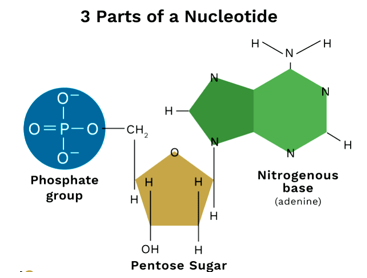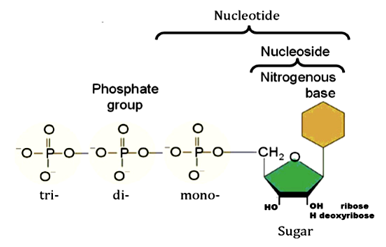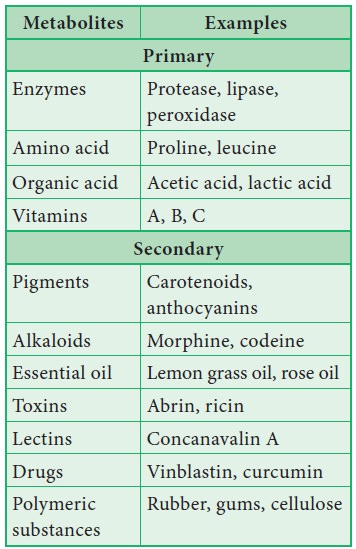- Nucleotides are monomeric units of nucleic acids. They are made of carbon, hydrogen, oxygen, nitrogen and phosphorus.
- Each nucleotide has a nitrogenous base, a pentose sugar and one to three phosphate groups

Nitrogenous base:
- It is a heterocyclic compound that can be either a purine (adenine or guanine) or a pyrimidine (thymine/cytosine/uracil).

- The nitrogenous base is linked to pentose sugar through n-glycosidic linkage

Pentose sugar
- The pentose sugаr may be ribose (ribonucleotide) or deoxyribose (deoxyribonucleotide).
- The nitrogenous base and pentose sugar together form a nucleoside.
Phosphate group
- When a phosphate group is attached to a nucleoside it is called a nucleotide.
- Nucleotides are mono- or di- or tri-phosphates of nucleosides.
Adenosine mono-phosphate (AMP)
Adenosine di-phosphate (ADP)
Adenosine tri-phosphate (ATP)
Functions of nucleotides
- Purine and pyrimidine nucleotides are the monomers forming nucleic acids.
- They also serve as sources of chemical energy (ATP, GTP)
- Higher nucleotides (with more than one phosphate group) store energy in their high-energy phosphate bonds.
- They also serve as sources of chemical energy (ATP, GTP)
- Nucleotides participate in cellular signalling (cAMP, cGMP)
- They function as important cofactors of enzymatic reactions (coA, FAD, FMN, NAD+).
- Nicotinamide and riboflavin nucleotides function as coenzymes for dehydrogenase (oxidising enzymes).
- They function as important cofactors of enzymatic reactions (coA, FAD, FMN, NAD+).
Primary and Secondary Metabolites
Most plants, fungi and other microbes synthesize a number of organic compounds. These components are called as metabolites. They are the intermediates and products of metabolism.
The term metabolite is usually restricted to small molecules. It can be catergorized into two types namely primary and secondary metabolites based on their role in metabolic process


Primary metabolites
- These are required for the basic metabolic processes like photosynthesis, respiration, protein and lipid metabolism etc. of living organisms.
- They are produced continuously during the growth phase of the organism.
- They are identical in most organisms.
Secondary metabolites
- These are the derivatives of primary metabolites.
- They do not show any direct function in growth and development of organisms.
- However, many of them are useful to ‘human welfare’ (e.g., rubber, drugs, spices, scents and pigments).
- Some secondary metabolites have ecological importance.